traditionalmass.org | Traditional Latin Mass Resources
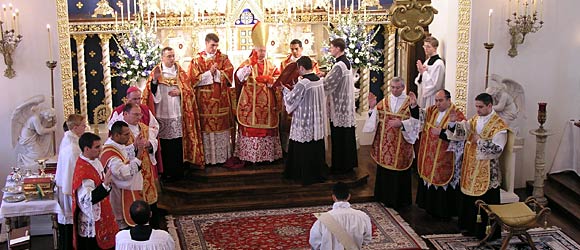
For further information contact: The Most Rev. Donald J. Sanborn
|
Florida Seminary Building Project
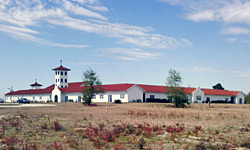
In 2003 Most Holy Trinity Seminary acquired 50 acres of land near Brooksville, Florida, (about 30 minutes north of Tampa) with a view towards constructing a new building and relocating its operations there. Construction began in January 2005.
Since then, the seminary has constructed a new building in the Spanish Mission style with about 40 rooms opening onto an arched walkway around a central courtyard. The building consists of a student rooms, faculty quarters, library (with 10,000 volumes), classrooms, recreation room, dining room, kitchen, laundry, service areas and a small chapel.
The large church has been completed, and the interior is finished in a Roman Classical style.
A Typical Day at the Seminary
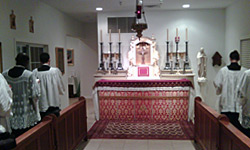
5:40 Rise
6:20 Meditation
7:00 Mass
7:50 Breakfast
9:00 Classes, Study
12:30 Lunch, Recreation
2:00 Classes, Study
4:00 Study
5:00 Vespers (chanted)
5:30 Spiritual Reading
6:00 Supper, Recreation
8:00 Compline (chanted)
8:20 Grand Silence
10:00 Lights Out
Most Holy Trinity Seminary: FAQs
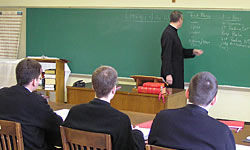
Q. Where is Most Holy Trinity Seminary?
A. In Fall 2005, the seminary moved to Brooksville, Florida (about 30 minutes north of Tampa). It is housed in a newly-constructed Spanish Colonial-style build on 50 acres of land, just off Interstate 75.
Q. Who is on the seminary faculty?
A. The Most Rev. Donald Sanborn, Fr. Anthony Cekada, Fr. Joseph Selway, Fr. Nicolas Désposito, Rev. Julian Larrabee.
Q. What courses would I take?
A. In humanities: Latin, history, literature, music and art appreciation, and English composition. In philosophy: Logic, Cosmology, Psychology, Ethics, Metaphysics, Criteriology, and Theodicy. In theology: Dogmatic Theology, Moral Theology, Canon Law, Sacred Liturgy, Sacred Scripture, Pastoral Theology, Church History and Homiletics.
Q. How long would it take to become a priest?
A. About seven years after high school, depending on your knowledge of Latin. Before Vatican II, a high school graduate spent eight years of study in the seminary before ordination: two years of humanities, two years of philosophy, and four years of theology. Because of the need for priests, we have condensed the course into seven years, but we have not left anything out.
Q. What is life in the seminary like?
A. The seminary is a beautiful life of peace, prayer and study. Ask an old priest, and he will tell you that the happiest days of his life were in the seminary. The seminary wants to take the young man and turn him into the young priest. It is therefore necessary to give him a moral, spiritual, liturgical, and intellectual training that will last him his whole life. For this reason, the seminarian has a schedule of prayer, both liturgical and private, a schedule of studies, and a schedule of other duties which prepare him for this end.
Q. How much does the seminary cost?
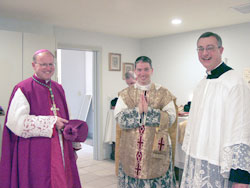
A. $4,000 per year. Those whose parents are unable or unwilling to pay all or part of this amount ought to seek help from benefactors. Their parish priests might be willing to sponsor them, and the candidate should not hesitate to ask. The seminarian might also pay his way be seeking summer employment in his parish or elsewhere. The seminarian also must pay for his own personal expenses, such as books, stationery, clothing, personal toilet articles, etc.
Q. Who will ordain me?
A. A validly-consecrated traditional Catholic bishop. The Most Rev. Daniel L. Dolan and the Most Rev. Donald J. Sanborn have ordained seminarians for Most Holy Trinity Seminary.
Q. What will I do after I am ordained?
A. To a great extent that depends on you. The bishop who ordains you will require either that you join an organization of priests, or commit to work with a bishop or an older priest approved by the seminary. Every kind of priestly work is open to you: parish work, schools, seminary training, missionary work, retreats, chaplaincies to convents, etc.
Q. What is the life of the priest like now?
A. It is not really different from what is was from any other time in the Church. To be sure, Vatican II has caused many problems in the Church, and because of them much confusion has resulted, but these are crosses which the priest of today must bear in order to maintain the true Faith and carry on the work of the Church.

Q. What qualifications must I have?
- A high school diploma for the major seminary program.
- A grade school diploma for the minor seminary program.
- Age not greater than thirty years. (Exceptions may be made in cases where a candidate has already received some traditional seminary training elsewhere.)
- A good reputation.
- Freedom from emotional/psychological problems.
- Good health. (Medical certificate will be required).
- Freedom from debt. (Payment of loans may be deferred, however, if the creditor is willing. This is often the case with student loans).
- Freedom from canonical impediments
Most Holy Trinity Seminary
Theological Directory
INTRODUCTORY PRINCIPLES
1. Most Holy Trinity Seminary is organized as a center for the training of Roman Catholic priests according to pre-Vatican II standards. The sole motive of its foundation and purpose of its functioning is to preserve the Roman Catholic priesthood, not only with regard to the validity of Holy Orders, but also with regard to the orthodoxy and proper training of Roman Catholic priests. The need for such a seminary is dictated by the doctrinal, liturgical, and disciplinary devastation which has been wrought in countless souls as a direct result of Vatican II and its subsequent changes.
2. The Seminary professes that Vatican II and the doctrinal, disciplinary and liturgical reforms which have proceeded from it are substantial alterations of the Catholic Faith. It professes that these heretical, evil, and blasphemous reforms can in no way proceed from the Roman Catholic Church, since she is infallible in her doctrines, her disciplines, and her liturgical worship. The Seminary therefore professes that the members of the Novus Ordo hierarchy (including and especially John Paul II), despite any and all appearances of authority, are not true Catholic popes nor true Catholic bishops, and do not possess the authority to rule, for they are the authors of the doctrinal, disciplinary and liturgical abominations which have invaded our holy places. The Seminary professes that they are false shepherds, and ought to be denounced as such.
3. The Seminary proposes, as the solution to the aberrations of Vatican II, the complete rejection of this council as a false council, including its decrees and enactments. The Second Vatican Council manifested itself to be a false council, and devoid of the assistance of the Holy Ghost, by the fact that it promulgated doctrines which were previously condemned by the Church The heretical nature of this council is confirmed by (1) the doctrinal interpretation given to Vatican II by Paul VI and his successors in their decrees, encyclicals, catechisms, etc.; (2) the series of abominations perpetrated by Paul VI and his successors against the First Commandment of God, in the form of ecumenical ceremonies which constitute false worship, even to pagan deities in some cases; (3) the alteration of the Sacred Liturgy in such a way that the Catholic Mass has been replaced by a Protestant supper service; (4) the tampering with the matter and form of the sacraments so that many of them, but most notably the Holy Eucharist and Holy Orders, labor under doubt or invalidity; (5) the promulgation of disciplines, especially the 1983 Code of Canon Law and the Ecumenical Directory, which approve of sacrilege against the Holy Eucharist and the Sacrament of Matrimony, and which demonstrate heresies concerning the unity of the Church as their theoretical basis; (6) the scandalous mockery made of the Sacrament of Matrimony by the granting of annulments for spurious reasons, constituting an abandonment of the sacred doctrine of the indissolubility of marriage; (7) the fact that Paul VI and his successors are in communion with manifest heretics, have openly declared themselves to be in communion with non-Catholic sects, and have recognized an apostolic mission in schismatic and Lutheran bishops, all of which destroys the unity of faith.
DOCTRINAL PRINCIPLES
4. Most Holy Trinity Seminary professes and adheres to everything which is contained in divine revelation, whether written or handed down, and which has been proposed by the Church as having been revealed by God either by her solemn judgment or by her ordinary and universal magisterium.
5. Because of the Seminary's adherence to the magisterium of the Church, it wholeheartedly rejects the heretical teaching of Vatican II concerning the unity of the Church, namely that the Church of Christ is not exclusively identified with the Catholic Church, but merely subsists in it. This heretical doctrine is contained principally in Lumen Gentium, and its heretical meaning is confirmed in statements of Paul VI and his successors, particularly in the 1983 Code of Canon Law, in the 1992 Statement concerning Church and Communion, and in the Ecumenical Directory. It is contrary to the teaching of the Catholic Church, contained principally in Satis Cognitum of Pope Leo XIII, Mortalium Animos of Pope Plus XI, Mystici Corporis of Pope Plus XI and in the condemnations of the "Branch Theory" made by the Holy Office under Pope Pius IX.
6. The Seminary also rejects the teaching of Vatican II concerning ecumenism as overtly heretical, which states that non-Catholic religions are a means of salvation. This doctrine directly contradicts the teaching of the Church that there is no salvation outside the Catholic Church, called by Pope Plus IX a "most well-known Catholic dogma." In addition, the ecumenical practices which have resulted from this heretical doctrine are directly contrary to Mortalium Animos of Pope Plus XI.
7. The Seminary rejects the teaching of Vatican II on religious liberty, contained in Dignitatis Humanae, which nearly word for word asserts the very doctrine which was condemned by Pope Plus VII in Post Tam Diuturnas, by Pope Gregory XVI in Mirari Vos, by Pope Plus IX in Quanta Cura, and by Pope Leo XIII in Libertas Praestantissimum. The teaching of Vatican II on religious liberty also contradicts the royalty of Jesus Christ in society as expressed in Quas Primasof Pope Plus XI, and the constant attitude and practice of the Church with regard to civil society.
8. The Seminary furthermore rejects the teaching of Vatican concerning collegiality, which attempts to alter the monarchical constitution of the Catholic Church, with which she was endowed by the Divine Savior. The doctrine of Vatican II, confirmed by the I983 Code of Canon Law, which states that the subject of the supreme authority of the Church is the college of bishops together with the pope, is contrary to the defined doctrine of the Council of Florence and of Vatican I.
LITURGICAL PRINCIPLES
9. The Seminary adheres to the Catholic liturgy of the Roman rite, pristine and untouched by the Modernists.
10. Consequently the Seminary rejects the Ordo Missae of Paul VI as an evil liturgical discipline, because (1) it contains a heretical definition of the Mass; (2) it was composed with the express purpose of making an ecumenical liturgy, pleasing to Protestants, stripped of Catholic truths concerning the priesthood, the Holy Sacrifice of the Mass, and the Real Presence of Christ in the Holy Eucharist; (3) it was composed with the help and input of six Protestant ministers, which shows the heretical spirit in which it was conceived and formulated; (4) its authors systematically deleted from its prayers and lessons doctrines which would be offensive to heretics; (5) it teaches, both by its omissions and its symbolism and gestures, heresies and errors concerning the priesthood, the Holy Sacrifice of the Mass, and the Real Presence of Christ in the Holy Eucharist; (6) it is most probably invalid owing to a defect of intention which it causes in him who celebrates it, and owing, at least in the vernacular, to a blasphemous alteration of the words of Christ in the consecration formula.
11. The Seminary furthermore rejects the Vatican II reforms of the other sacraments, which participate in the same spirit of ecumenical apostasy. Notable among these is the Vatican II rite of Orders, which has deleted the notion of a sacrificing priesthood and has substantially changed the form of the sacrament from that set down by Pope Pius XII in Sacramentum Ordinis.
12. The Seminary also rejects the reforms of the Missal and Breviary made in 1955 and thereafter, because they were designed and concocted by the same Annibale Bugnini, the author of the Ordo Missae of Paul VI. When seen in the subsequent light of the ultimate reforms of Vatican II, it is clear that the 1955 reforms of the Mass and of Holy Week in particular are inchoately the same reforms as those of Vatican II. The legal justification for the rejection of these rites, which were promulgated by a true Roman Pontiff, is the principle of epicheia, since if there were a Pope reigning at the present time, it is reasonable to presume that he would not want these inchoative changes to be used by the Church.
DISCIPLINARY PRINCIPLES
13. The Seminary adheres to the 1917 Code of Canon Law.
14. The Seminary consequently rejects the I983 Code of Canon Law because (1) it is promulgated by John Paul II, a false pope, who has no jurisdiction to make any laws for the Catholic Church, owing to his promulgation of the Vatican II heresies and errors; (2) it contains the heresy of Vatican II concerning the Church, mentioned above; (3) it permits sacrilege to the Blessed Sacrament, by approving of its reception by non- Catholics, which is a mortal sin; (4) it permits communicatio in sacris with non- Catholics, which is a mortal sin.
15. The Seminary offers as its legal justification for its existence, and of the apostolate of those priests who shall emanate from the Seminary, the principle of epicheia. In the absence of the lawmaker, i.e., a true Pope, one may reasonably presume that it is the will of the Church, and therefore lawful and even required of the faithful, especially the clergy, to carry on the mission of the Church to save souls. And since this can only be done by the offering of the Holy Sacrifice of the Mass and the distribution of Sacraments, it is required that the clergy make every effort to accomplish this end.
GOALS AND OUTLOOK
16. The Seminary's immediate goal is to train priests according to the pre- Vatican II standards. The ultimate goal of the Seminary is to solve the problem of Vatican II. The only solution to the problem of Vatican II, however, is to condemn it as a false council which was dominated by heretics, and to discard and ignore its decrees and enactments. Consequently, the Seminary does not seek to be recognized by the heretical hierarchy which promulgates Vatican II, nor does it seek to work with the Novus Ordo clergy, as if in a single church or religion. The Seminary therefore repudiates the idea of the Indult Mass, or that of a fraternity of priests which has received permission or seeks permission from the Novus Ordo hierarchy to function in communion with the Modernist heretics.
17. The Catholic Church, in the outlook of the Seminary, will not be cured of its current problems until the hierarchical sees, particularly the papacy, are once again occupied by Catholics. For as long as Modernist heretics possess the mere appearance of authority which they now possess, the problem of Vatican II will continue. In the meantime the Seminary, as well as the priests who emanate from it, shall abhor even the suggestion of an official recognition from the Novus Ordo hierarchy, or of a compromise with the Modernists, whom St. Plus X called the "most pernicious of all the enemies of the Church," who are striving "utterly to subvert the very Kingdom of Christ."
Why You Should Become a Priest
The Disaster of Vatican II
Never was there a time in the history of the Church when priests were so badly needed as today. But strangely enough, young men in our day have virtually abandoned the service of the Church.
Vatican II set into motion the project that had been the dream of the enemies of the Church for the previous 150 years: to change the Catholic Faith into a dogma-less, humanitarian religion---one whose goal would be to draw all religions and all peoples into one featureless church that would be an amalgam of all religions and churches. Because of the vast size and influence of the Catholic Church, it made more sense to the Church's enemies to change her from within, and to make her the vehicle to spread the creed of the "deification of man."
Since Vatican II, we have seen our Catholic institutions, while remaining the same in name and external appearance, undergo profound interior changes. We find in these institutions a religion completely different from that of pre-Vatican II times. While the same cathedrals, the same churches, seminaries, universities and religious orders still exist, the religion in them is entirely different.
The Heresy of Modernism
This new religion is the heresy of modernism, which St. Pius X called the "synthesis of all heresies" in his solemn condemnation of it in 1907. The saint also warned that even then the modernists had infiltrated the Church with express purpose of changing her from within. He warned that if they ever succeeded in their goal to change the Faith according to the principles of modernism, it would result in the destruction of the Church, if that were possible.
This profound and substantial alteration of our Faith was accomplished by John XXIII and Paul VI, and has been augmented and continued by John Paul II. Having gained the position of power in 1958 in the person of John XXIII, the modernists wasted no time in promoting their destructive and heretical ideas, and consolidated their power in the hierarchy. The result is that the Catholic Faith, as it existed from the time of Saint Peter to the time of Pope Pius XII, is now outlawed in those institutions which were founded and built to be a home for it.
The Catholic Resistance Needs Priests
It is the will of God to work through men, and to overcome His enemies by giving power to men. The Church therefore, by the help and grace of God, must overcome this enemy within her by means o fmen. These men must be priests and bishops, since the Church cannot survive as the true Church unless she have priests and bishops. All of her essential functions of teaching, ruling, and sanctifying the faithful upon earth, which she derives from the sacred mission confided to her by Christ, can only be carried on by priests and bishops.
The only way the Faith will survive the modernist infiltration and poisoning is through the ministry of priests who reject the changes of Vatican II, recognize the enemy, condemn and resist him,and protect the flock of Christ from further devouring by wolves. This principle was true during every assault of heresy upon the Church in the past. How much more is it true during the intense and ultimate assault by her enemies in our own days?
The Church has never failed to be fruitful and vibrant in her resistance to her enemies. She has within her the very means to combat those who wish to bring her down. These weapons are Catholic doctrine, Catholic sacraments, the Catholic Mass, and Catholic discipline. For these things are the truth, and the strength of the Church is that she is inpossession of the truth --- truth from God, supernatural and infallible.This is her strength, for the human race has a natural attraction to the truth. The more the Church displays her truth, the more she overcomes her enemies.
You are Called to Sacrifice
For this reason, despite terrible odds, she overcame the dire persecutions of the early centuries. To the terrifying decrees of emperors and to the machines of torture which they displayed in order to kill her, she displayed in return, by the blood of her martyrs, merely her truth. For three centuries the Church had to fight what seemed to be a losing battle. It was a battle of people with no human power or weapons against those who had all human power and weapons. Yet in the end it was the Church that was victorious. This glorious victory she gained by remaining steadfast to her Faith, and by showing it to the whole world by the blood of her martyrs.
So in these times, when she is not threatened from without but from within, the Church must display her truth. This she can only do through the ministry of priests and bishops who are faithful to true Catholic doctrine and true Catholic liturgy. Today's martyr must be the young man who is willing to give up the pleasures and opportunities of this world, and dedicate his life --- give up his life --- to God and His holy Church for the sake of the salvation of souls.
It was to train young men to become this type of priest that Most Holy Trinity Seminary was founded in 1995.
Vocations: FAQs
Q. How do I know that I have a vocation?
A. A vocation to the priesthood is simply God's will that you become a priest. The problem arises in knowing God's will for you in this life. Vocations do not usually happen by visions or interior voices, but rather by signs — signs in your character, piety, and inclinations that the Holy Ghost is moving you to the priesthood. These are the ordinary signs of vocation:
- A genuine and constant inclination of mind to serve God as a priest. You feel attracted to the life the priest, and to ecclesiastical things. You might be interested in the liturgy, sacred dogma, or missionary work. There is something about the priesthood that draws you.
- A genuine desire to promote the glory of God and of His Church, and the salvation of souls. This is the real work of the priest, and at times demands great sacrifices. This is the only true motive of becoming a priest. It would be wrong to become a priest for the wrong motive, for example, because people would have great respect for you.
- A good moral life. One of the signs of not having a vocation is the inability to stay out of mortal sin for a long time. But this requirement does not mean you must be a saint to consider the priesthood; it simply means that you must be serious about your spiritual life, that you frequent the sacraments often, avoid occasions of sin, and lead an upright life.
- Piety. The life of a priest is a life of prayer, and part of a vocation to the priesthood is an inclination to prayer - liturgical prayer and private prayer.
- Emotional stability. The priest must be a father to all, and must bear the problems of all, and cannot himself be burdened with emotional and psychological problems.
- At least average intelligence. The priest must faithfully transmit Catholic doctrine to the faithful, and accurately diagnose their sins in the confessional. Hence he must have at least average intellectual ability to pass his seminary courses.
- Good physical health. The priest must be in good physical condition in order to carry out his work. Those who suffer from chronic illnesses or who are handicapped cannot enter the priesthood.
Q. What if I am in doubt about my vocation?
A. You should go to a good priest whom you know and ask him what he thinks. Ask him to be your regular confessor, and acquaint him candidly with all of your weaknesses and temptations, as well as your strengths and gifts, and trust him to counsel you. Even more importantly, pray fervently and perseveringly to God that you be enlightened in this matter.
Q. Shouldn't I wait to go to the seminary until I'm older or have graduated from college?
A. Absolutely not. A vocation is frequently lost by delay. Four years of college will give you only distractions, heavy debts to pay, temptations, and courses that will not get you any closer to the priesthood. Better to heed the call as soon as you hear it. Remember, too, that the seminary is where a young man tests his vocation by living the clerical life. Whether or not you truly have a vocation will become clear after some time in the seminary.
©2007 traditionalmass.org. Powered by Wordpress

